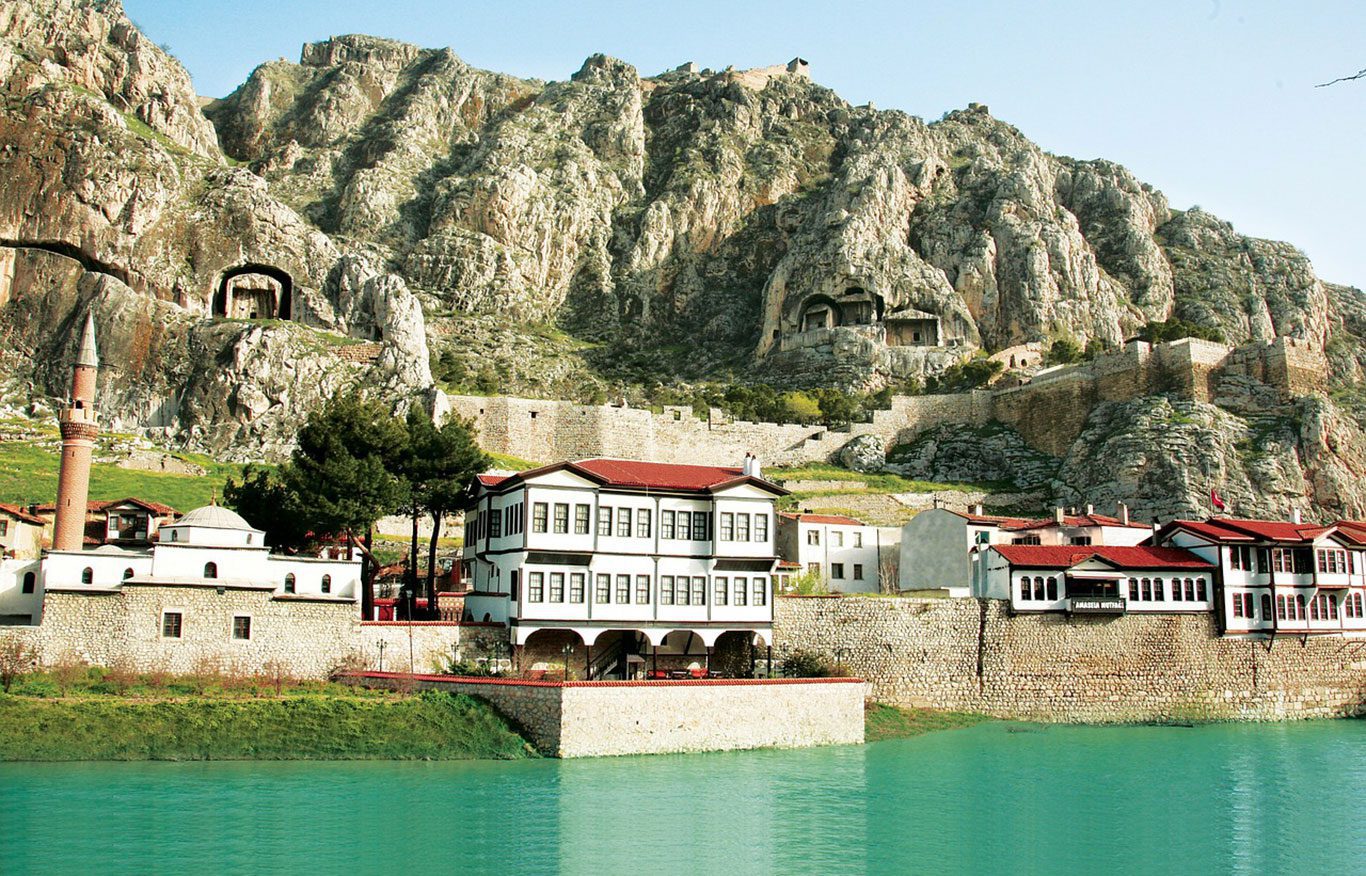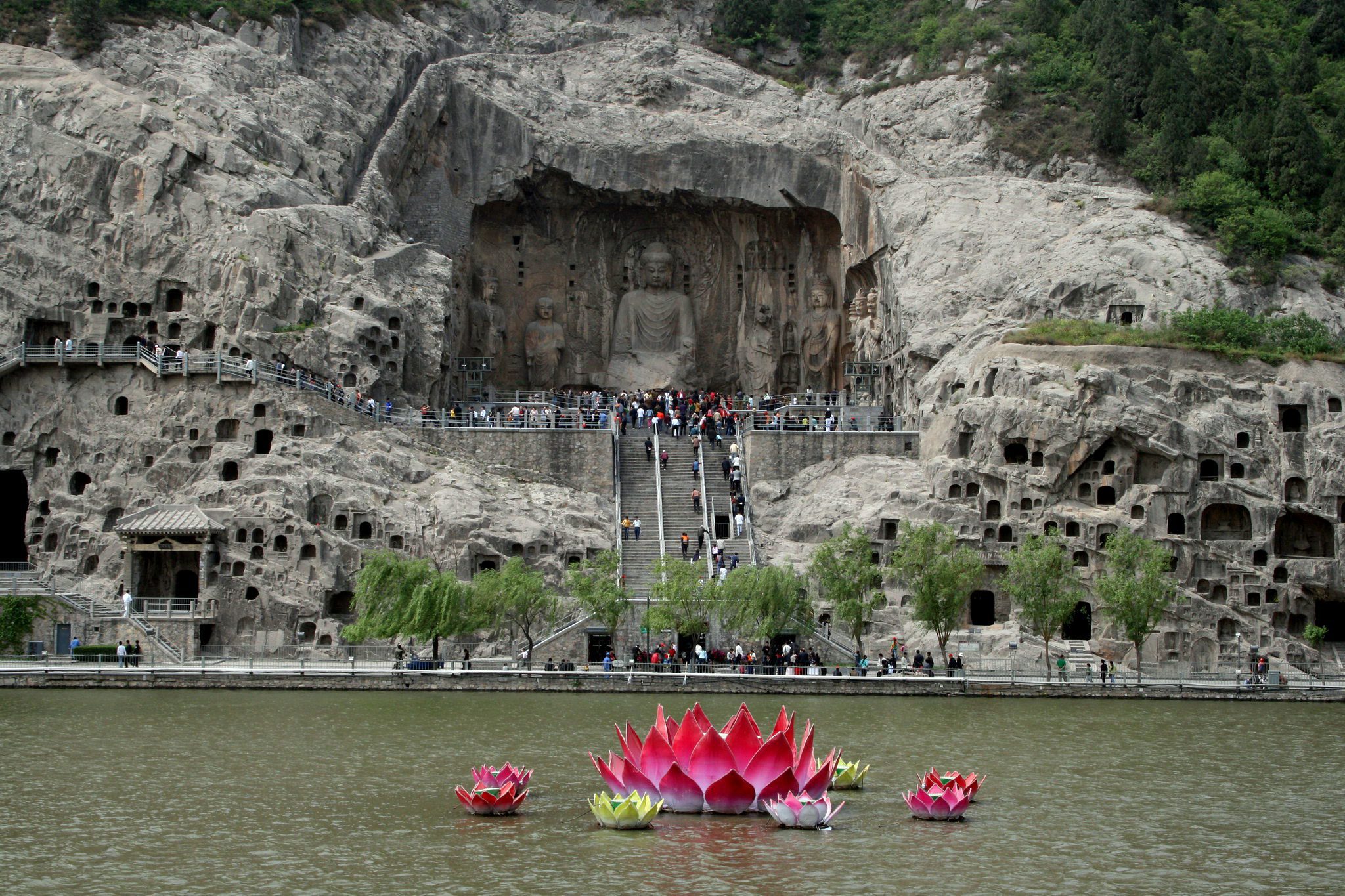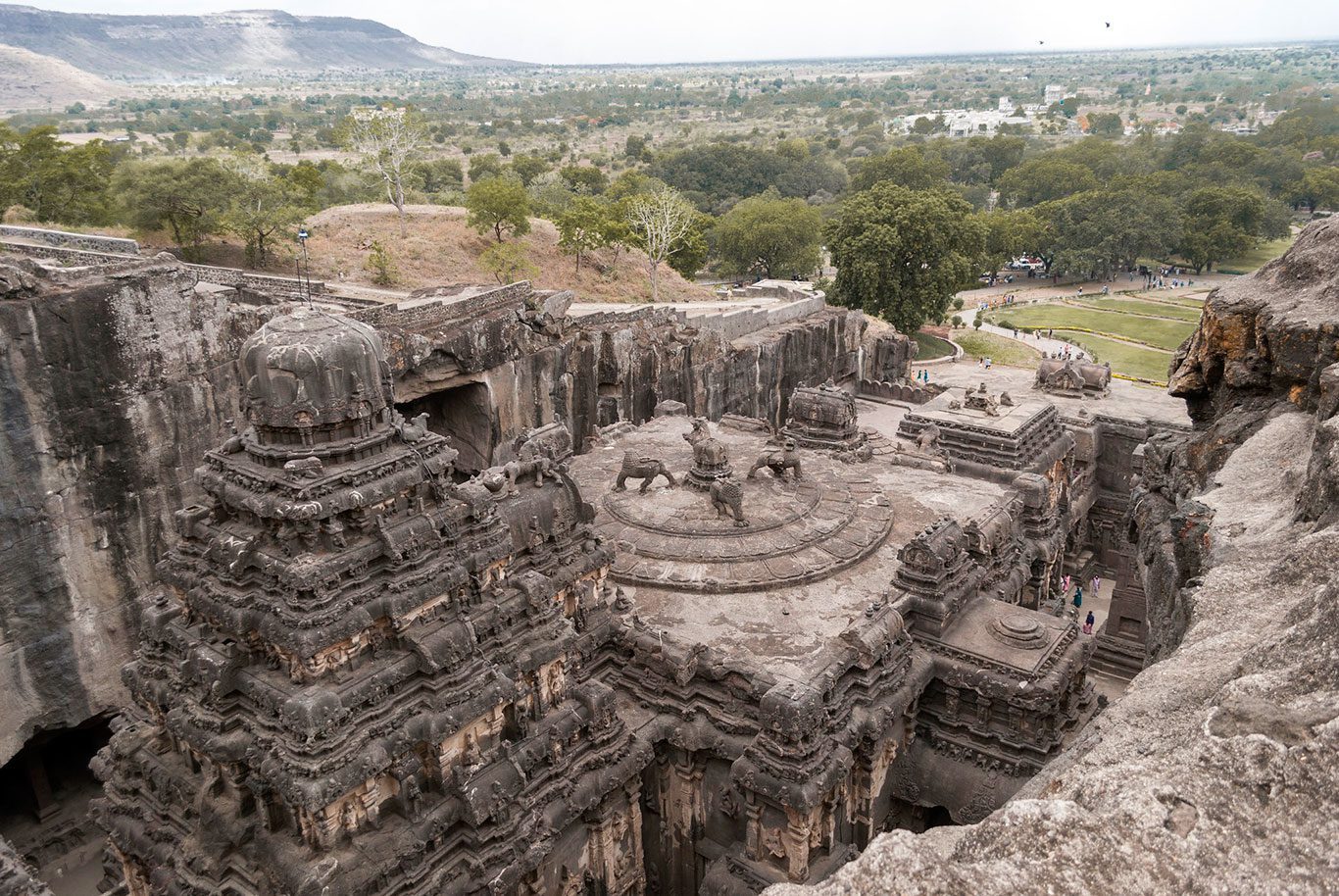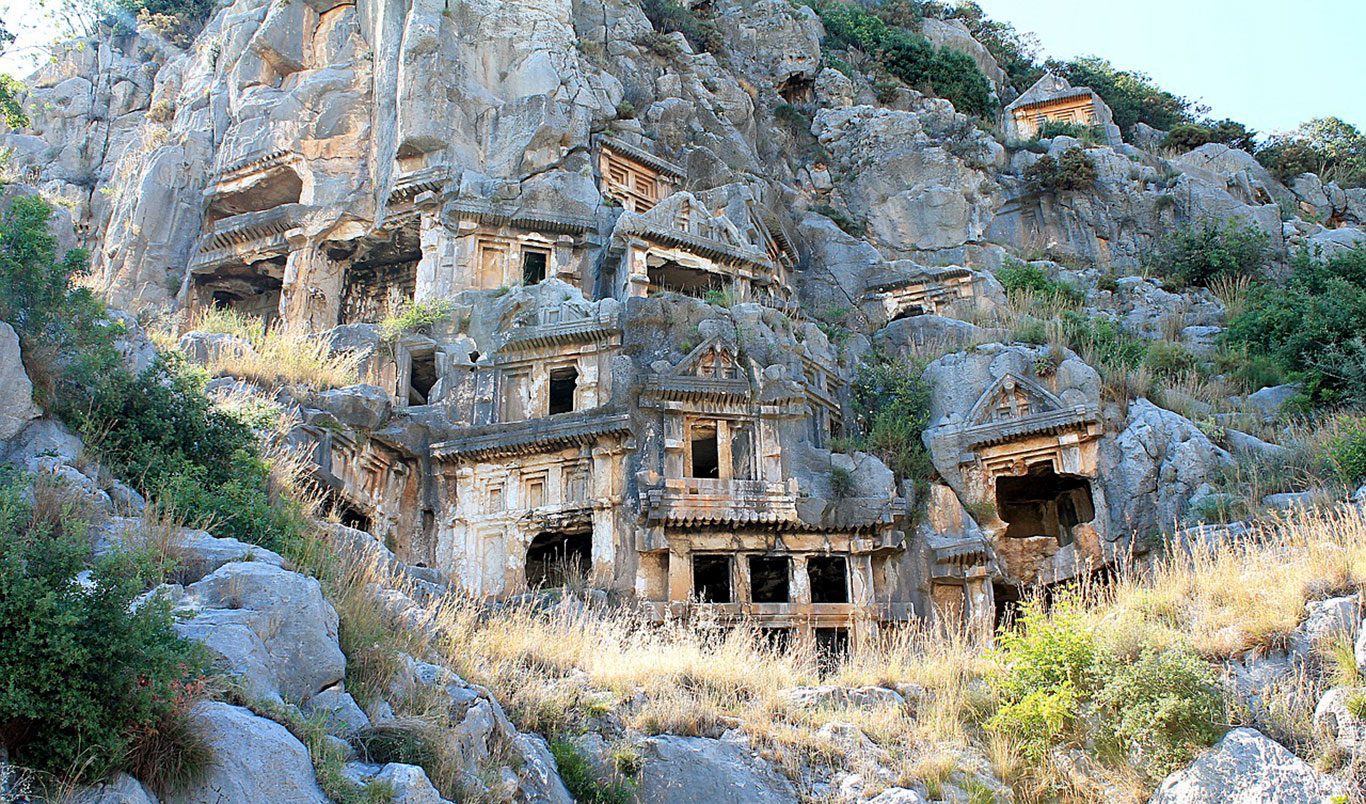Lycian Tombs near Dalyan Village in Turkey
Located near the village of Dalyan in Turkey, Lycian Tombs are carved into the mountain rock, resembling with small huts dating from ancient times. Their shapes vary depending on the social status of those buried, the most impressive of course belongs to those with noble blood. Besides the tombs of ancient populations of this territory, here was found also a collection of old coins of a special historical significance.
These tombs were built into the side of a mountain so that ancient angels could reach the dead. Carved into the side of a Turkish mountain are what it looks to be the entrances to countless temples, but are in fact the ornate façade of ancient Lycian tombs near the village of Dalyan.

There are several types of Lycian tombs, the most common of which is the rock-cut tomb. The earliest examples of these are said to have been carved in the 5th century BC, and can be found in places such as Myra and Amasya, Turkey.
Another form of Lycian tombs is the sarcophagus. Although this is a common form of burial, Lycian sarcophagi are unique for their great size. These structures consist of three parts: a base, a grave-chamber, and a pointed lid.
The Lycians seem to have held a belief that the souls of their dead would be transported from the tombs to the afterworld by a sort of winged siren-like creature, and so often placed their tombs along the coast or at the top of cliffs when they were not integrated into the livable areas of the cities.
Rock-Carved Churches of Lalibela
In Ethiopia, the small town of Lalibela has one of the most visited places of worship in the world: no less than 13 churches carved in stone, with the roof located at ground level. Initially, the site was known as Roha, then King Lalibela changed it in the twelfth century, when he began digging these impressive churches.
The rock-carved churches of Lalibela are considered to be “one of the most sacred Ethiopian archaeological sites”, representative for the ancient civilization of Jerusalem.
This Rock-hewn Churches are located in the Western Ethiopian Highlands near the town of Lalibela, named after the late-12th and early-13th century King Gebre Mesqel Lalibela of the Zagwe Dynasty, who commissioned the massive building project of 11 rock-hewn churches to recreate the holy city of Jerusalem in his own kingdom. The site remains in use by the Ethiopian Orthodox Christian Church to this day, and it remains an important place of pilgrimage for Ethiopian Orthodox worshipers.
Image Gallery Courtesy of Henrik Berger Jørgensen via Flickr
City of Petra
The stone city of Jordan’s wilderness is an archaeological site famous for its architecture, carved almost entirely in the stone of the mountain. One of the most precious cultural properties of man’s heritage, as UNESCO calls it, the city of Petra impresses any pilgrim through its unique sculptures in the world. The most elaborate belong to Al Khazneh temple, being clearly influenced by Ancient Greek architecture.
Petra is a historical and archaeological city in the southern Jordan that is famous for its rock-cut architecture and water conduit system. Another name for Petra is the Rose City due to the color of the stone out of which it is carved.
Established possibly as early as 312 BCE as the capital city of the Nabataeans, it is a symbol of Jordan, as well as Jordan’s most-visited tourist attraction. It lies on the slope of Jebel al-Madhbah (identified by some as the biblical Mount Hor) in a basin among the mountains which form the eastern flank of Arabah (Wadi Araba), the large valley running from the Dead Sea to the Gulf of Aqaba. Petra has been a UNESCO World Heritage Site since 1985.
Image Gallery Courtesy of Dennis Jarvis, Sylvain L & Colin Tsoi via Flickr
Pliny the Elder and other writers identify Petra as the capital of the Nabataeans and the center of their caravan trade. Excavations have demonstrated that it was the ability of the Nabataeans to control the water supply that led to the rise of the desert city, creating an artificial oasis. The area is visited by flash floods and archaeological evidence demonstrates the Nabataeans controlled these floods by the use of dams, cisterns and water conduits. These innovations stored water for prolonged periods of drought, and enabled the city to prosper from its sale.
The Nabataean settlement does not go back farther than the 6th century BCE. A period follows in which the dominant civilization combines Greek, Egyptian and Syrian elements, clearly pointing to the age of the Ptolemies. Towards the close of the 2nd century BCE, when the Ptolemaic and Seleucid kingdoms were equally depressed, the Nabataean kingdom came to the front. Under Aretas III Philhellene, (c.85–60 BCE), the royal coins begin. The theatre was probably excavated at that time, and Petra must have assumed the aspect of a Hellenistic city.
The Artistic Grottoes from Longmen
In China, Xiangshan and Longmenshan Mountains host the artistic Grottoes from Longmen, that hold thousands of statues that represent Buddha and his disciples. The first statues were built between 400 and 1100 BC, through the contribution of religious groups and wealthy families of those times. UNESCO called these immortal works of art “an outstanding manifestation of human artistic creativity” for good reason.
The Grottoes started to be built in 494 Emperor Xiaowen of Northern Wei moved the capital to Luoyang, and the construction had been kept on thru Eastern Wei, Northern Qi, Northern Zhou, Sui, Tang until the Song Dynasty. Over 100,000 Buddhist status have been preserved in over 2,300 grottoes. In 2000, Longmen Grottoes was in scribed on the World Heritage List.

Ellora, India
Few people know that the archaeological site Ellora in India is hosting, most likely, the largest stone carvings from around the globe. They reflect the traditions of Hindu, Buddhist and Jain and are dating from 5-10th century.
Each cave is distinguished by a remarkable beauty, being living witnesses of ancient civilizations spirituality. The monuments illustrate perfectly the spirit of tolerance characteristic of ancient India, which allowed the three religions to establish their sanctuaries and communities in one place.


